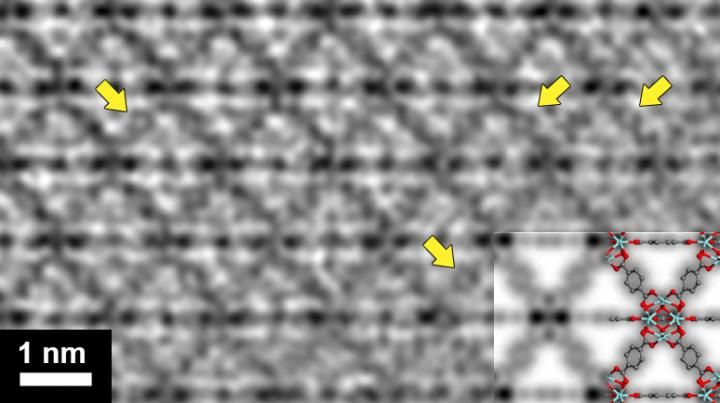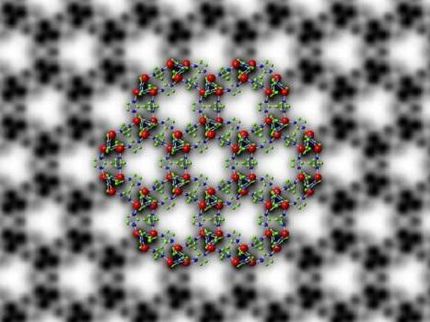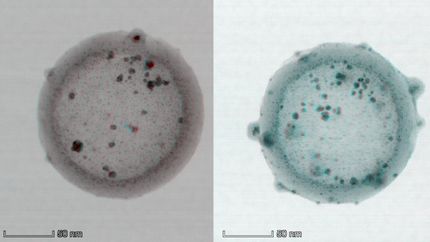Crystal clear
Staff members at King Abdullah University of Science and Technology (KAUST) devised a methodology for the procurement of atomically resolved images of beam-sensitive materials using transmission electron microscopy. Daliang Zhang, Rachid Sougrat and Kun Li from the KAUST Core Laboratories, in conjunction with Professor Yu Han and team members Yihan Zhu, Lingmei Liu, Xiangrong Ying and Chia-En Hsiung, published their findings.

CTF-corrected high-resolution TEM image from a MOF UiO-66 crystal. The benzene rings in the crystal are indicated by arrows. Overlays are simulated projected potential map and structural model for comparison.
KAUST
"High-resolution imaging of electron beam-sensitive materials is one of the most difficult applications of transmission electron microscopy (TEM). The salient challenges are the acquisition of images using extremely low electron doses, the time-constraint inherent in the search for crystal zone axis prior to the sample being damaged, precise image alignment and the accurate determination of the defocus value," Han explained.
The methodology devised at KAUST to fulfill these requirements has been proven by the acquisition of atomic-resolution TEM images of several metal organic frameworks (MOFs) and other similar beam sensitive materials, "reducing this procedure to a near-routine process," Li said.
Although high-resolution TEM (HRTEM) is a powerful tool for structure characterization, it is not easily applied to electron-beam sensitive materials such as MOFs, which require ultra-low electron doses to remain intact. The recent introduction of the direct electron detection cameras has provided scientists with the capability of realizing an image in ultra-low dose mode (only a few electrons per square angstrom), but the potential of such a camera in the HRTEM imaging of electron beam-sensitive materials is still limited by the inhibiting obstacles: sourcing a zone axis, aligning images and determining an accurate defocus value.
"Our team at KAUST first developed an algorithm enabling us to achieve a one-step alignment of the zone axis while keeping the specimen intact. Unfortunately, due to inherent issues when dealing with beam-sensitive materials, HRTEM would still produce blurred images mainly due to sample drift during exposure," Han said. "To overcome this, a series of successive short exposures were taken. These, however, resulted in very noisy frames. An amplitude filter technique was developed to minimize noise and accurately align all the frames."
Also, to reconstruct the structure, the team designed a process making use of the instability of beam-sensitive materials to determine the absolute defocus value from the purposely amorphized region.
These processes, which were developed at KAUST and incorporate two provisional patents, are not just limited to beam-sensitive materials. The method for zone axis alignment is also particularly pertinent for the aligning of nanosized crystals, and that for image alignment is generally applicable to noisy images with periodic features.
"This seminal paper has not only significantly broadened the applications of HRTEM, but it has also provided the beam-sensitive materials researchers with a powerful tool capable of investigating the structure of beam-sensitive materials in much more localized detail than traditional X-ray diffraction techniques permit," Li explained. "This will undoubtedly facilitate beam-sensitive materials researchers in the designing of new structures with enhanced performance."
Original publication
Most read news
Original publication
Zhang, Daliang and Zhu, Yihan and Liu, Lingmei and Ying, Xiangrong and Hsiung, Chia-En and Sougrat, Rachid and Li, Kun and Han, Yu; "Atomic-resolution transmission electron microscopy of electron beam-sensitive crystalline materials"; Science; 2018
Topics
Organizations
Other news from the department science

Get the chemical industry in your inbox
By submitting this form you agree that LUMITOS AG will send you the newsletter(s) selected above by email. Your data will not be passed on to third parties. Your data will be stored and processed in accordance with our data protection regulations. LUMITOS may contact you by email for the purpose of advertising or market and opinion surveys. You can revoke your consent at any time without giving reasons to LUMITOS AG, Ernst-Augustin-Str. 2, 12489 Berlin, Germany or by e-mail at revoke@lumitos.com with effect for the future. In addition, each email contains a link to unsubscribe from the corresponding newsletter.


























































